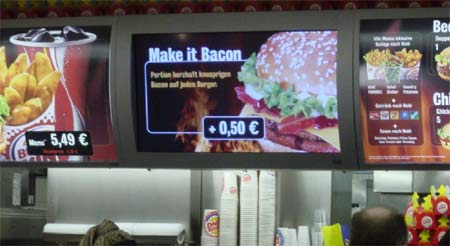Article
Serving up Profits with Digital Menu Boards
Digital menu boards can attract viewers, generate product excitement and have a tangible effect on revenue.

August 29, 2005 by James Bickers — Editor, Networld Alliance
Typically, restaurants count on the reliability of their front-line staff to offer the upgrade to each and every customer. Since that staff consists of human beings, though, that doesn't always happen.
Some large chains have experimented with digital signage as an accompaniment to their traditional static menu boards. These displays allow them to serve up eye-catching animations and designs that remind customers to "make it a large."
Two different strategies, two different results Different companies have taken different approaches, some more successful than others. Jeff Porter, executive vice president of Scala Inc., pointed to a recent McDonald's installation that involved replacing all of a store's menu boards with plasma displays, allowing the dynamic updating of prices, "and occasionally, a Big Mac would wiggle to draw your attention."
Burn-in was a problem, he said, due to the static images. Worse still, average revenue per customer wasn't improved. "Just because a Big Mac wiggled from time to time did not cause customers to pay more for a Big Mac or buy two Big Macs," he said.
Alternately, Burger King introduced a digital menu system in 300 of its Germany stores, but with a different focus: Rather than replace the existing system entirely, a single 42" screen was placed in the middle of the static signage, and that display was used to push daily specials and upgrades.
"Guess what? It worked," Porter added. "Average revenue shot up and the cost to deploy the system? A lot less than replacing all the menu boards with screens. Burn-in was not an issue here, since there was no static imagery on the screen."
So how typical was the Burger King experience? Do other restaurants stand to benefit from adding a digital component to their in-store menus and signage?
"Unofficial, anecdotal evidence says 'Yes,'" said Brad Gleeson, president and chief operating officer of digital display pioneer ActiveLight Inc. "Of the pilots I am aware of, the challenge presented was to drive sales of higher-margin goods. Reports have shown double-digit increases in same-store sales of these items where the item was displayed using digital signage."
A strong branding and back-office tool Gleeson said that digital menu signage does more than just push specials – the displays become vehicles for more robust branding and co-op opportunities.
"Cross-over promotions such as movies are an obvious one, but now other brand sponsors – such as the nearby theme park – can reach this audience where previously it had been difficult or impractical," he said.
Porter is keen to point out another benefit of digital signage – the network infrastructure required to deliver menu and marketing content can also be used to deliver other materials, even when the store is closed. For instance, in the case of Burger King GmbH, the displays were used to allow the company CEO to deliver a motivational message to all of the chain's employees just before opening time each day.
Likewise, signage networks are excellent vehicles for training, eliminating the need for videocassettes or DVDs shipped from the home office. "That's an amazingly powerful tool for an amazingly small investment," he said.
Slow but steady adoption Like any new technology, adoption is slow, especially given the cost – this is not an insubstantial investment. The franchise system also creates difficulties in rolling out new solutions.
"You almost have to sell the solution one store at a time," Gleeson said. "Since these chains tend to be franchise-based, the final decision-maker tends to be the franchisee. The corporate HQ generally doesn't want to have to pay for the technology, and so the local storeowner must be convinced. There's always a bit of 'Sure, it worked in that store, but my market is different' that must be overcome."
And while there might come a day when the lion's share of restaurants replace their static menus entirely, Gleeson doesn't see that day coming in the near future.
"Eventually it may be practical to replace all menu boards with digital displays, but that it's probably overkill," he said. "Customers and chains are very comfortable with the format of their existing static menu boards and are using the technology to enhance this rather than replace it."




